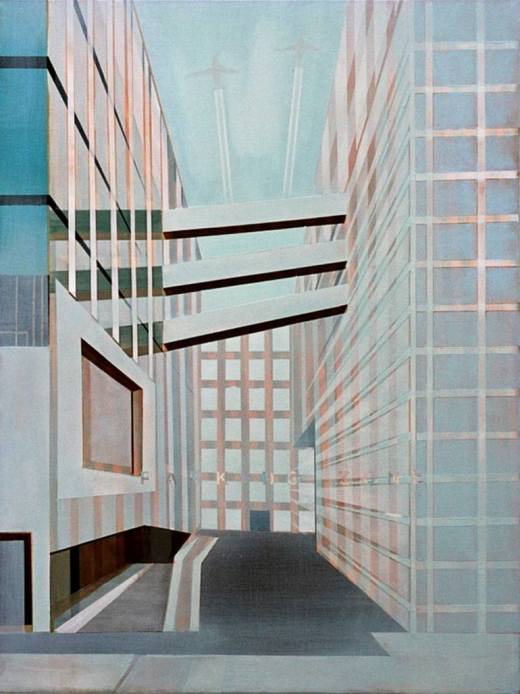“I think that a work of art is an answer to the obtrusiveness of idealised advertisement aesthetics, a reaction to the avalanche of daily life impressions from the street, internet and television. In my opinion it should create consciousness and filtrate our perception, so that we can distinguish importance from humbug, and provide us a home for our emotions, confusions and fears,” says Dutch artist Cécile van Hanja, who was born in Corsica and currently lives and works in Haarlem. She graduated from the Gerrit Rietveld Academie of Amsterdam in 1993.
Cécile’s body of work is an engaged and prolonged look at the architecture of our era, a careful study of the structures, extents and limits of our personal and public spaces. “My chief source of inspiration is the modernism at the beginning of the 20th century,” she tells, “especially the architecture of Bauhaus (Germany) and De Stijl (the Netherlands). These movements are reflections of order in a time of chaos. The big windows in the buildings of Mies van der Rohe were a reason to paint light. For me, contemporary art is part of a binding story that connects and creates unity. Mondrian as a pioneer in his strive for harmony and unity on canvas also inspires me a lot.”
So her art displays and celebrates the power and wide appeal of a design based on simple geometry and basic colour. She hopes the viewer perceives universal beauty, calmness and harmony in her work. But that is not everything. Cécile also intends to mildly unsettle the audience and make them think about the negative aspects of the our urban situation. She elaborates: “I certainly admire art most when it stands for universal beauty and gives us peace and quiet as a reaction to the fleeting consumer society. Yet in my work, I tend to combine the utopian beauty of modernism with emptiness and desolation.”
The stylistic allure of modernist architecture goes hand in hand with a serious sense of suspense. Cécile depicts contemporary man-made areas in all their airless and lifeless neutrality. “Empty rooms,” she says, “like those in office buildings, are biological homes for a while and then we leave them. These anonymous environments generate suspense. The feeling that behind every door, around every corner, a possible threat awaits. Also, in modern society, there is a heavy feeling of alienation among people. We live in a world in which people do not know their neighbours, in which the architecture creates a sort of loneliness, a poverty of contact between people. My work, thus, asks people to consider the politics of buildings and raises questions on the responsibility of architects in creating these economic spaces.”
Check out Cécile’s website (www.cecilevanhanja.com), Saatchi Art (www.saatchiart.com/cécilevanhanja) and Facebook pages (www.facebook.com/PaintingsCecilevanhanja).












—-
Further Reading:
Modern Architecture (Oxford History of Art) (2002) by Alan Colquhoun
Modern Forms: A Subjective Atlas of 20th-Century Architecture (2016) by Nicolas Grospierre
The Tale of Tomorrow: Utopian Architecture in the Modernist Realm (2016) by
—-
![]()

Universal beauty indeed !
LikeLiked by 1 person
Amazing paintings, especially the the black/white /grey ones.
LikeLiked by 1 person
Yes!
LikeLiked by 1 person
Enjoyed these pieces – created in what medium? Thanks.
LikeLiked by 1 person
Thanks. It says “Acrylic and Oil on Canvas” on her Saatchi Art profile.
LikeLiked by 1 person
Good article, always a learning experience with you.
LikeLiked by 1 person
Thank you 🙂 Planning to try out new things here…
LikeLike
This was an interesting read!
I came across another article on ‘Suspense in Art’.
Check it out – https://bit.ly/33UcMsz
LikeLike
This was an interesting read!
I came across another article on ‘Discovering a Pimento’.
Check it out – https://bit.ly/33UcMsz
LikeLike